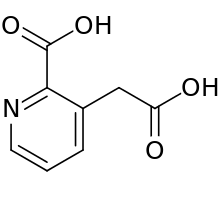Homoquinolinic acid
Homoquinolinic acid (HQA) is a potent excitotoxin[1] which is a conformationally-restricted analogue of N-methyl-D-aspartate (NMDA) and a partial agonist of the main/glutamate site of the NMDA receptor, with some selectivity for NR2B subunit-containing receptors.[2][3][4] It is approximately equipotent to NMDA and about five times more potent than quinolinic acid as an agonist of the NMDA receptor.[5] HQA has also been found to label a novel, yet uncharacterized binding site, which can be distinguished from the NMDA receptor with the use of 2-carboxy-3-carboxymethylquinoline (CCMQ), a selective ligand of the uncharacterized site.[6]
 | |
| Clinical data | |
|---|---|
| Other names | Homoquinolinate |
| ATC code |
|
| Identifiers | |
| |
| CAS Number | |
| PubChem CID | |
| ChemSpider | |
| PDB ligand | |
| CompTox Dashboard (EPA) | |
| ECHA InfoCard | 100.164.902 |
| Chemical and physical data | |
| Formula | C8H7NO4 |
| Molar mass | 181.147 g·mol−1 |
| 3D model (JSmol) | |
| |
| |
See also
References
- T. W. Stone (1989). Quinolinic acid and the kynurenines. CRC Press. ISBN 978-0-8493-6592-8.
- Ian P. Stolerman (31 July 2010). Encyclopedia of Psychopharmacology. Springer Science & Business Media. pp. 511–. ISBN 978-3-540-68698-9.
- Prado De Carvalho, Lia; Bochet, Pascal; Rossier, Jean (1996). "THE ENDOGENEOUS AGONIST QUINOLINIC ACID AND THE NON ENDOGENOUS HOMOQUINOLINIC ACID DISCRIMINATE BETWEEN NMDAR2 RECEPTOR SUBUNITS". Neurochemistry International. 28 (4): 445–452. doi:10.1016/0197-0186(95)00091-7. ISSN 0197-0186.
- Thomas L. Lemke; David A. Williams (24 January 2012). Foye's Principles of Medicinal Chemistry. Lippincott Williams & Wilkins. pp. 404–. ISBN 978-1-60913-345-0.
- C.S.A. Neurosciences Abstracts. Cambridge Scientific Abstracts. 1984.
- Jan Egebjerg; Arne Schousboe; Povl Krogsgaard-Larsen (4 October 2001). Glutamate and GABA Receptors and Transporters: Structure, Function and Pharmacology. CRC Press. pp. 73–. ISBN 978-0-203-29938-8.
This article is issued from Wikipedia. The text is licensed under Creative Commons - Attribution - Sharealike. Additional terms may apply for the media files.